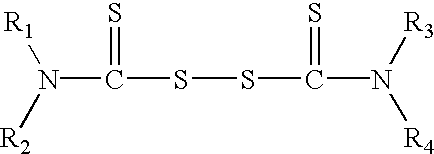Preparation of polysulfide compositions
a technology of polysulfide composition and composition, which is applied in the preparation of hydropoly/poly sulfide, other chemical processes, organic chemistry, etc., can solve the problems of increasing the molecular weight of polymers, producing significant quantities of waste water, and difficult to carefully control the precise value of the reduced molecular weigh
- Summary
- Abstract
- Description
- Claims
- Application Information
AI Technical Summary
Benefits of technology
Problems solved by technology
Method used
Image
Examples
example 1
[0051]A 3-liter round-bottomed flask was fitted with heating mantle, reflux condenser, mechanical stirrer, thermocouple, and an inlet for tubing from a peristaltic pump. The outlet of the reflux condenser was connected to a pair of 2-liter Erlenmeyer flasks, one of which was charged with 122.3 gram sodium hydroxide pellets and 1020.5 gram water. The round-bottomed flask was charged in succession with 1323.9 gram of sodium hydrosulfide aqueous solution (32.53% by weight sodium hydrosulfide, based on the total weight of the solution, filtered through Dicalite™ 4200, a diatomite filtration aid supplied by Grefco Inc., and glass fiber filter paper) and 61.6 gram of sulfur powder. The suspension was stirred at approximately 500 rpm and warmed to a target temperature of 80° C. As the temperature reached approximately 30° C., the sulfur appeared to dissolve, and bubbles believed to be hydrogen sulfide were observed to form. The solution turned from yellow to dark orange red, typical of pol...
example 2
[0055]A 3-liter round-bottomed flask was fitted with heating mantle, reflux condenser, mechanical stirrer, thermocouple, and an inlet for tubing from a peristaltic pump. The outlet of the reflux condenser was connected to a pair of 2-liter Erlenmeyer flasks, one of which was charge with 122.3 gram sodium hydroxide pellets and 1020.5 gram water. The round-bottomed flask was charged in succession with 1323.0 gram of sodium hydrosulfide aqueous solution (32.53% by weight sodium hydrosulfide, based on the total weight of the solution, filtered through Dicalite™ 4200 and glass fiber filter paper) and 61.8 gram of sulfur powder. The suspension was stirred at approximately 500 rpm and warmed to a target temperature of 80° C. As the temperature reached approximately 30° C., the sulfur appeared to dissolve, and bubbles believed to be hydrogen sulfide were observed to form. The solution turned from yellow to dark orange red, typical of polysulfide formation. When the temperature reached appro...
PUM
| Property | Measurement | Unit |
|---|---|---|
| Time | aaaaa | aaaaa |
Abstract
Description
Claims
Application Information
 Login to View More
Login to View More - R&D
- Intellectual Property
- Life Sciences
- Materials
- Tech Scout
- Unparalleled Data Quality
- Higher Quality Content
- 60% Fewer Hallucinations
Browse by: Latest US Patents, China's latest patents, Technical Efficacy Thesaurus, Application Domain, Technology Topic, Popular Technical Reports.
© 2025 PatSnap. All rights reserved.Legal|Privacy policy|Modern Slavery Act Transparency Statement|Sitemap|About US| Contact US: help@patsnap.com


